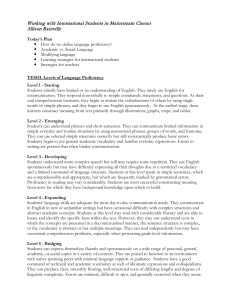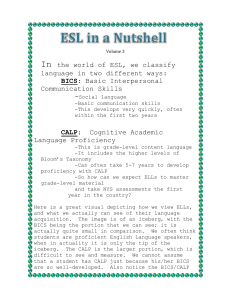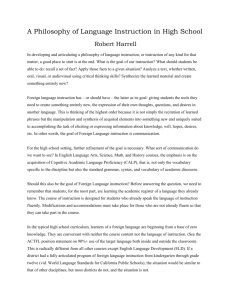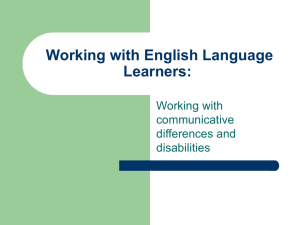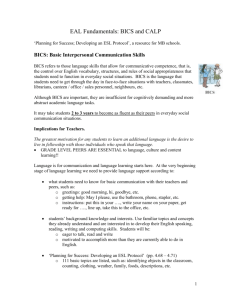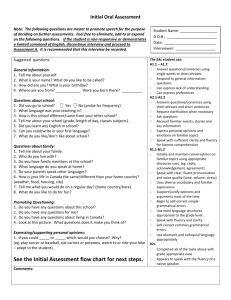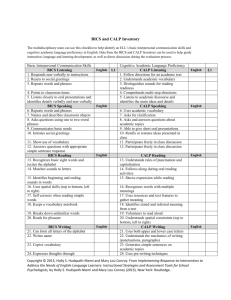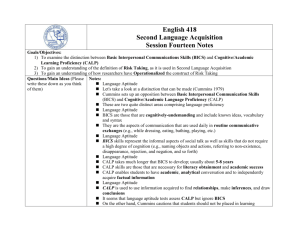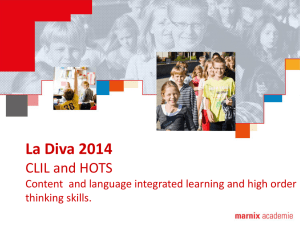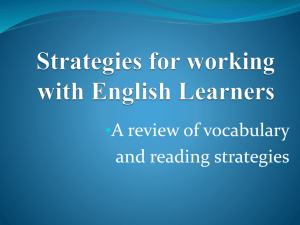Language Proficiency Scores
advertisement
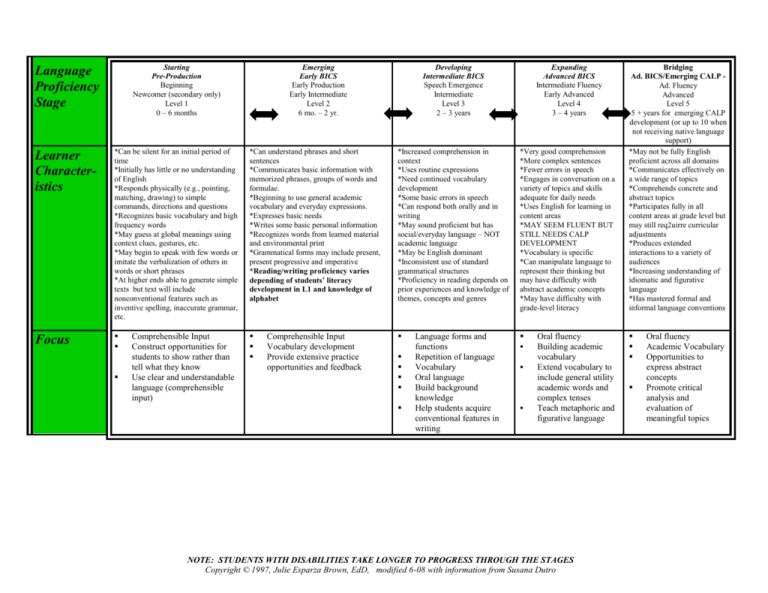
Language Proficiency Stage Starting Pre-Production Beginning Newcomer (secondary only) Level 1 0 – 6 months Learner Characteristics *Can be silent for an initial period of time *Initially has little or no understanding of English *Responds physically (e.g., pointing, matching, drawing) to simple commands, directions and questions *Recognizes basic vocabulary and high frequency words *May guess at global meanings using context clues, gestures, etc. *May begin to speak with few words or imitate the verbalization of others in words or short phrases *At higher ends able to generate simple texts but text will include nonconventional features such as inventive spelling, inaccurate grammar, etc. Focus Comprehensible Input Construct opportunities for students to show rather than tell what they know Use clear and understandable language (comprehensible input) Emerging Early BICS Early Production Early Intermediate Level 2 6 mo. – 2 yr. Developing Intermediate BICS Speech Emergence Intermediate Level 3 2 – 3 years Expanding Advanced BICS Intermediate Fluency Early Advanced Level 4 3 – 4 years *Can understand phrases and short sentences *Communicates basic information with memorized phrases, groups of words and formulae. *Beginning to use general academic vocabulary and everyday expressions. *Expresses basic needs *Writes some basic personal information *Recognizes words from learned material and environmental print *Grammatical forms may include present, present progressive and imperative *Reading/writing proficiency varies depending of students’ literacy development in L1 and knowledge of alphabet *Increased comprehension in context *Uses routine expressions *Need continued vocabulary development *Some basic errors in speech *Can respond both orally and in writing *May sound proficient but has social/everyday language – NOT academic language *May be English dominant *Inconsistent use of standard grammatical structures *Proficiency in reading depends on prior experiences and knowledge of themes, concepts and genres *Very good comprehension *More complex sentences *Fewer errors in speech *Engages in conversation on a variety of topics and skills adequate for daily needs *Uses English for learning in content areas *MAY SEEM FLUENT BUT STILL NEEDS CALP DEVELOPMENT *Vocabulary is specific *Can manipulate language to represent their thinking but may have difficulty with abstract academic concepts *May have difficulty with grade-level literacy Comprehensible Input Vocabulary development Provide extensive practice opportunities and feedback Language forms and functions Repetition of language Vocabulary Oral language Build background knowledge Help students acquire conventional features in writing Oral fluency Building academic vocabulary Extend vocabulary to include general utility academic words and complex tenses Teach metaphoric and figurative language NOTE: STUDENTS WITH DISABILITIES TAKE LONGER TO PROGRESS THROUGH THE STAGES Copyright © 1997, Julie Esparza Brown, EdD, modified 6-08 with information from Susana Dutro Bridging Ad. BICS/Emerging CALP Ad. Fluency Advanced Level 5 5 + years for emerging CALP development (or up to 10 when not receiving native language support) *May not be fully English proficient across all domains *Communicates effectively on a wide range of topics *Comprehends concrete and abstract topics *Participates fully in all content areas at grade level but may still req2uirre curricular adjustments *Produces extended interactions to a variety of audiences *Increasing understanding of idiomatic and figurative language *Has mastered formal and informal language conventions Oral fluency Academic Vocabulary Opportunities to express abstract concepts Promote critical analysis and evaluation of meaningful topics Appropriate Learner Response listen, point, move, nod, mime, match, draw, select, choose, act out, circle, gesture, yes/no, say names of other students, categorize, respond to commands, repeat Leveled Questions Teaching Strategies name, label, group, respond, discriminate, either/or questions, list, categorize, tell/say/answer, yes/no answers, use sound/symbol relationships in known words and read high frequency words Show me…? Circle the …? Where is…? Who has…? Use visuals and pictures Clear speech, emphasize key words, use more pauses between phrases Key words written on board; students may copy as appropriate Modeling TPR (pointing, nodding) Repeat and review Do not use slang words or idioms Use manipulatives Teach writing conventions Illustrate concepts Choral reading recall, retell, define, explain, compare, recite, summarize, describe, role-play, restate, contrast, write short paragraph, fill out form, list, underline, provide details, Yes/no questions Either/or questions Who, what and how many questions Open-ended sentences Open dialogue TPR with verbal responses Ask Who, What, Where questions Simple rhymes New vocabulary in context Language experience Provide interaction with print using word frames, etc. Continue teaching writing conventions Partner and trio reading Role playing Frame questions so answer is embedded as part of the question Why…? How…? Explain…? Questions requiring a phrase or shortsentence answers. Games Group discussion Gather information from charts, tables and graphs Read newspaper ads How, why questions Oral reading by teacher Scaffold texts Use grade appropriate content themes to build English academic content vocabulary Explicitly and systematically teach language forms and functions create, support, examine, state opinion, give instructions, negotiate meaning, paraphrase, outline and mapping, reading aloud, poetry, plays, read, write, summarize, debate, develop clear thesis, compose narrative and expository text What would happen if…? Why do you think…? Questions requiring more than a one sentence response. analyze, defend, debate, predict, evaluate, justify, hypothesize and synthesize, restate, critique Oral discussions Essay writing Analysis of charts Activities designed to develop higher levels of language comprehension and use in content areas Reading and writing activities incorporated into lessons Model variety of sentence structures and paragraphing Sheltered instruction NOTE: STUDENTS WITH DISABILITIES TAKE LONGER TO PROGRESS THROUGH THE STAGES Copyright © 1997, Julie Esparza Brown, EdD, modified 6-08 with information from Susana Dutro Decide if… Retell… Continue vocabulary development in all content areas Content-based Instruction Provide authentic practice opportunities to develop fluency and automaticity in communication Teach and scaffold to grade level standards
